Fresh Turnip Greens smothered in a rich stock with smoky ham, onions, and common South Louisiana seasonings. A bit of heat and a bit of sweetness are drawn out during a long braise resulting in tender, sweet and savory greens infused with a subtle smoky background flavor. With so much flavor, you’d think it takes a lot of work, but Sweet Daddy D’s Smothered Turnip Greens are so simple you’ll wonder what you were waiting for.
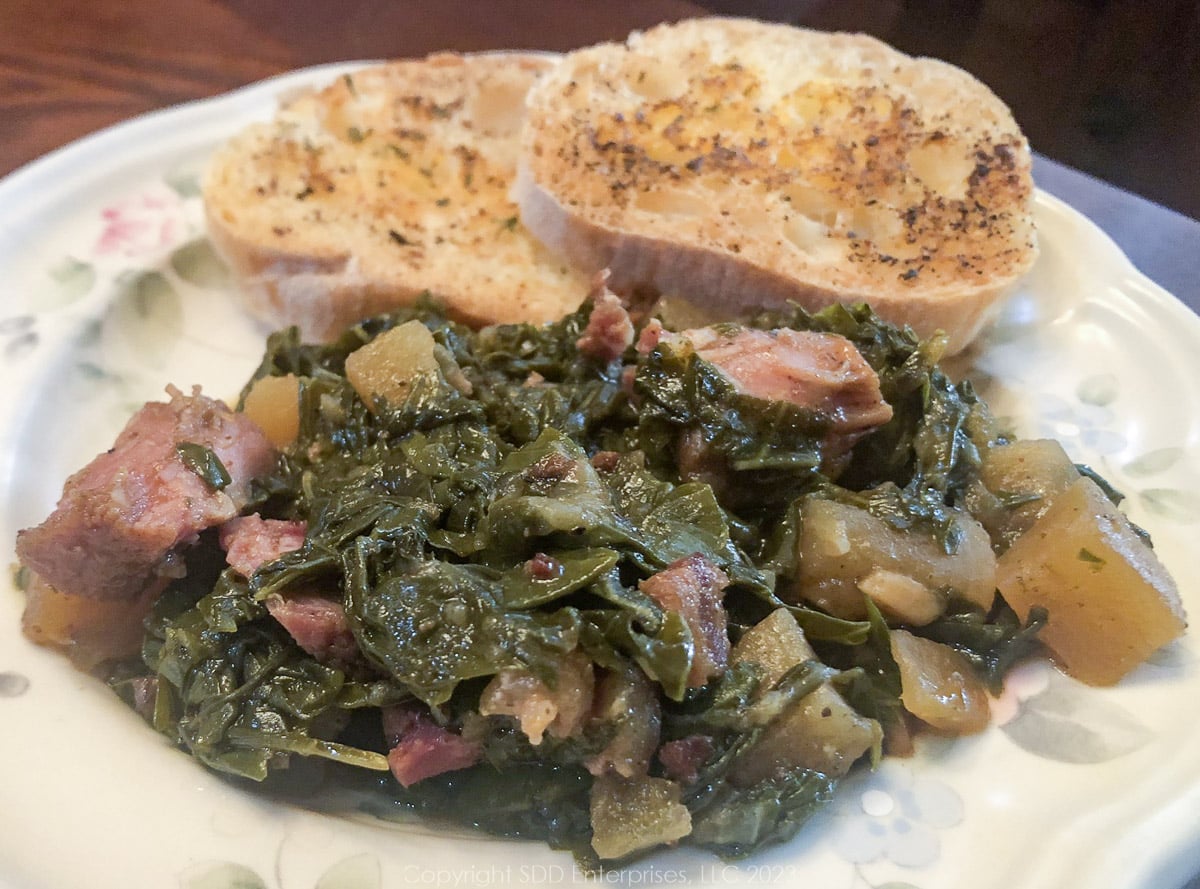
This post is not sponsored, but you will find affiliate links on this page. As an Amazon Associate, I earn from qualifying purchases. The price you pay as a consumer does not change, but I may make a small commission based on your purchase.
Jump to:
Turnip Greens in Cajun and Creole Cooking
Smothered Turnip Greens are commonly identified as Southern cooking, specifically Soul Food. Although different than Creole cuisine, where smothered greens are concerned, the roots (pun intended) are very similar. Slowly cooking green leafy vegetables with meats and peppers was common among West African slaves when they arrived in the Deep South. In Creole Louisiana, these same West African processes and ingredients would fuse with other cultural influences to develop a distinctive cuisine separate and apart from Southern cooking. The significant influences made by West African slaves on Creole cuisine are still present today in neighborhood Creole restaurants throughout New Orleans.
When the Acadians arrived in their new homeland in South Louisana, turnips were already a familiar vegetable, having been available to them before leaving the Canadian Maritimes. Turnips met the need of frugal Cajun cooks to stretch meager resources. They were able to use the entire turnip plant, both roots and stems, and use their long, slow one-pot cooking methods. Smothered Turnips were seasoned with pork pieces from the Boucherie which were not suitable for other purposes.
A variety of green leafy vegetables grew in abundance in the fertile soils and subtropical climate of South Louisiana. In the hands of Creole and Cajun cooks these were welcome ingredients that fit well with their history and needs.
Here’s What You Need

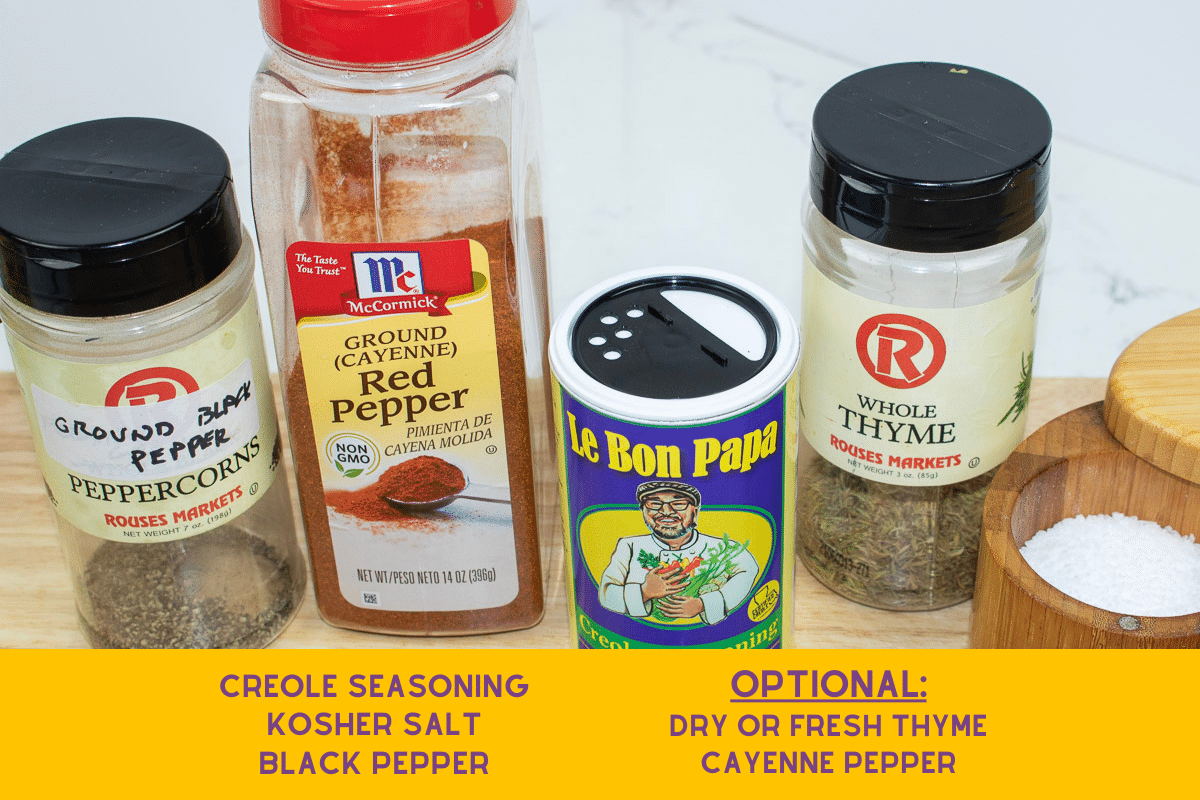
Pro Tip: I developed this recipe using my original Creole Seasoning (Le Bon Papa Creole Seasoning). This is an all-purpose NO SALT Creole Seasoning, so if you use another brand, check the salt content before adding salt to the recipe.

Note on the greens: This recipe was developed using fresh turnip greens. You can substitute any type of greens you like (collard, kale, mustard) or use a combination. You may find bags of greens already cleaned and chopped in your grocery store. These are fine to use and save a lot of time and work.
Note on the Cane Syrup: I used Louisiana Cane Syrup when developing this recipe to provide a mild sweetness in the background and offset some of the turnip greens' natural bitterness. The amount that I use is not overpowering but you can certainly use more or less, or leave it out altogether. You could also substitute white or brown sugar.
Note on the use of vinegar: A touch of acid helps offset the natural bitterness and coaxes out a pleasant flavor in turnip greens. I used Cane Vinegar with 5% acidity. You can substitute apple cider vinegar or white vinegar (both of which are 5% acidity) or some fresh lemon juice.
Note on the seasoning meat: This recipe was developed using sliced, smoked ham shanks. To me, this product adds both a smokiness that is essential in smothered Turnip Greens as well as some nice ham meat to augment the flavor profile. You can substitute smoked ham hocks (which may not have very much meat on them) or smoked turkey necks or wings which will provide the smokiness and some delicious meat. Pickled Pork is also a popular seasoning meat. It's not smoked, but it will make a positive contribution to the flavor profile and lots of delicious meat.
Note on the bacon: Smoked bacon adds so much flavor that I can't imagine not using it. Maybe more important than the flavor is that bacon provides the fat in which we cook the vegetables. Substitute vegetable oil, lard, olive oil, or butter.
These products make this dish just a little better:
Equipment
Here is some of the equipment I used in making this recipe:
This post is not sponsored, but you will find affiliate links on this page. As an Amazon Associate, I earn from qualifying purchases. The price you pay as a consumer does not change, but I may make a small commission based on your purchase.
Here’s What You Do
First…you have a beer. The best way to enjoy the process of cooking is to approach it with the right frame of mind. Eliminate the angst of cooking by preparing yourself and preparing the ingredients before you start. Pop open a beer and sip while you read the recipe all the way through. Now you'll know what you need and what you will do with each ingredient. Then, it's time to perform your mise en place before you ever get near the stove.
Mise En Place
- Prepping the Greens:
- Remove the thick stem from the leaves by (1) flattening each leaf and (2) running a sharp knife along each side of the stem. You can also tear the stem with your hands, or turn the leaf on its side folded at the stem, then chop off the length of the stem.
- (3) Rinse the greens under running cold water or by placing them in a bowl of cold water. Toss or agitate the leaves to loosen any dirt. Empty the bowl of water and repeat two or three times, depending on how dirty the leaves are. The water should get cleaner each time you change it.
- (4) Place the cleaned greens in a strainer or colander to drain. It's not necessary to completely dry the leaves before you cook them.
- Rough-chop the leaves and set them aside.

Pro Tip: Don't chop the leaves too small. By the time they are smothered down, you will have a better mouth feel if the pieces of greens start out with a larger, rough cut.
Slice the onions into half moons.
- Slice the bacon into ½ inch pieces.
- Peel and cube the turnips into approximately ½ inch cubes.
- Rough-chop the garlic.
- Measure the remaining ingredients.

Build a flavor foundation
What happens in this step? We start with the seasonings that provide foundational flavors. Sauteing the onions in bacon fat until starting to turn translucent will bring out the sweetness of the onions which when mixed with the aromatics establishes the foundational flavor.
Starting in a cold Dutch oven, fry the bacon until the fat has rendered. This will take about 10 minutes.
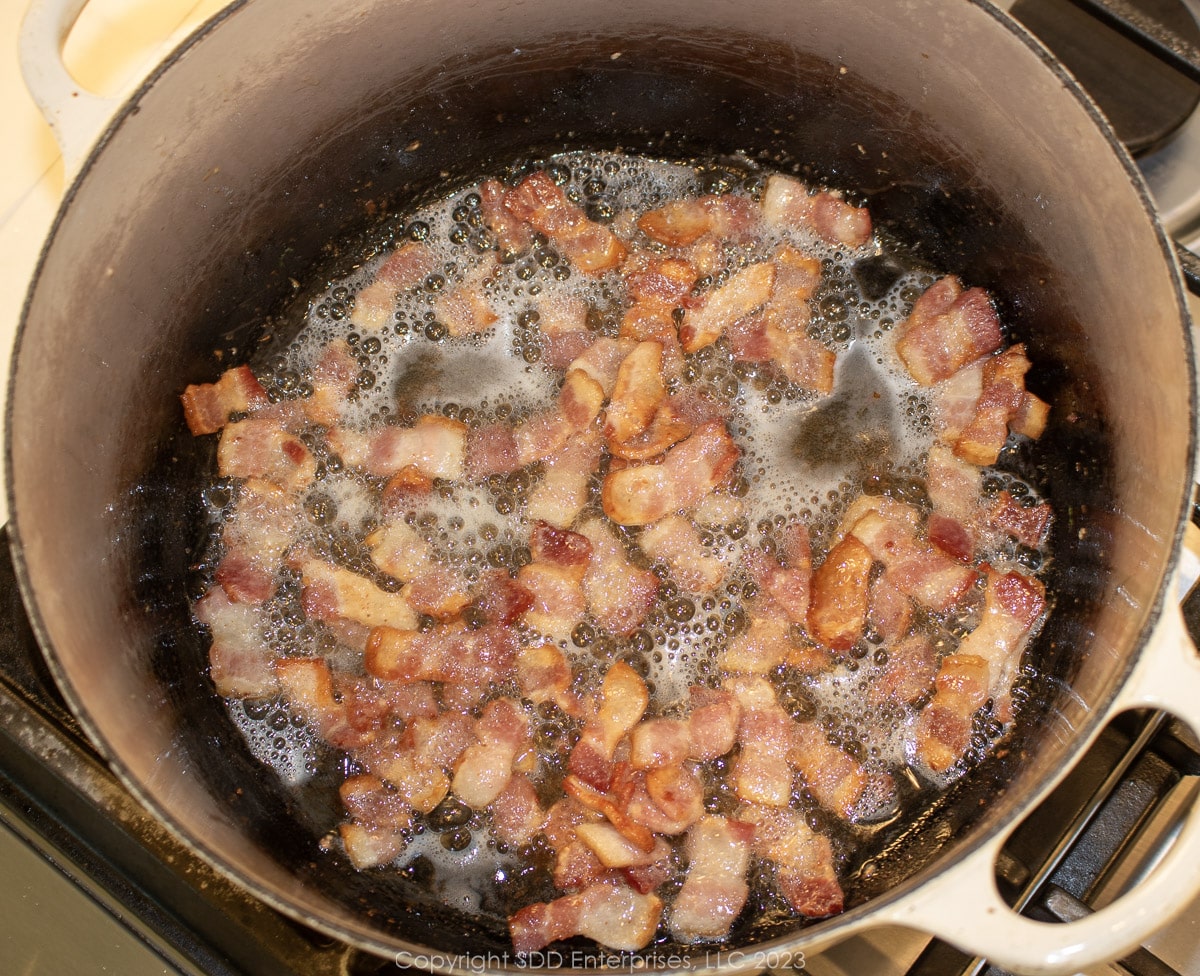
Leaving the bacon in the Dutch oven, sear the ham shank on both sides, then remove the shank from the Dutch oven and reserve. This will take about 5 minutes.

Add the sliced onions and saute until they are turning translucent. This should take about 8 minutes.

Next, add the garlic and the Herb and Spice Blend and saute for about 2 more minutes or until the garlic is aromatic.
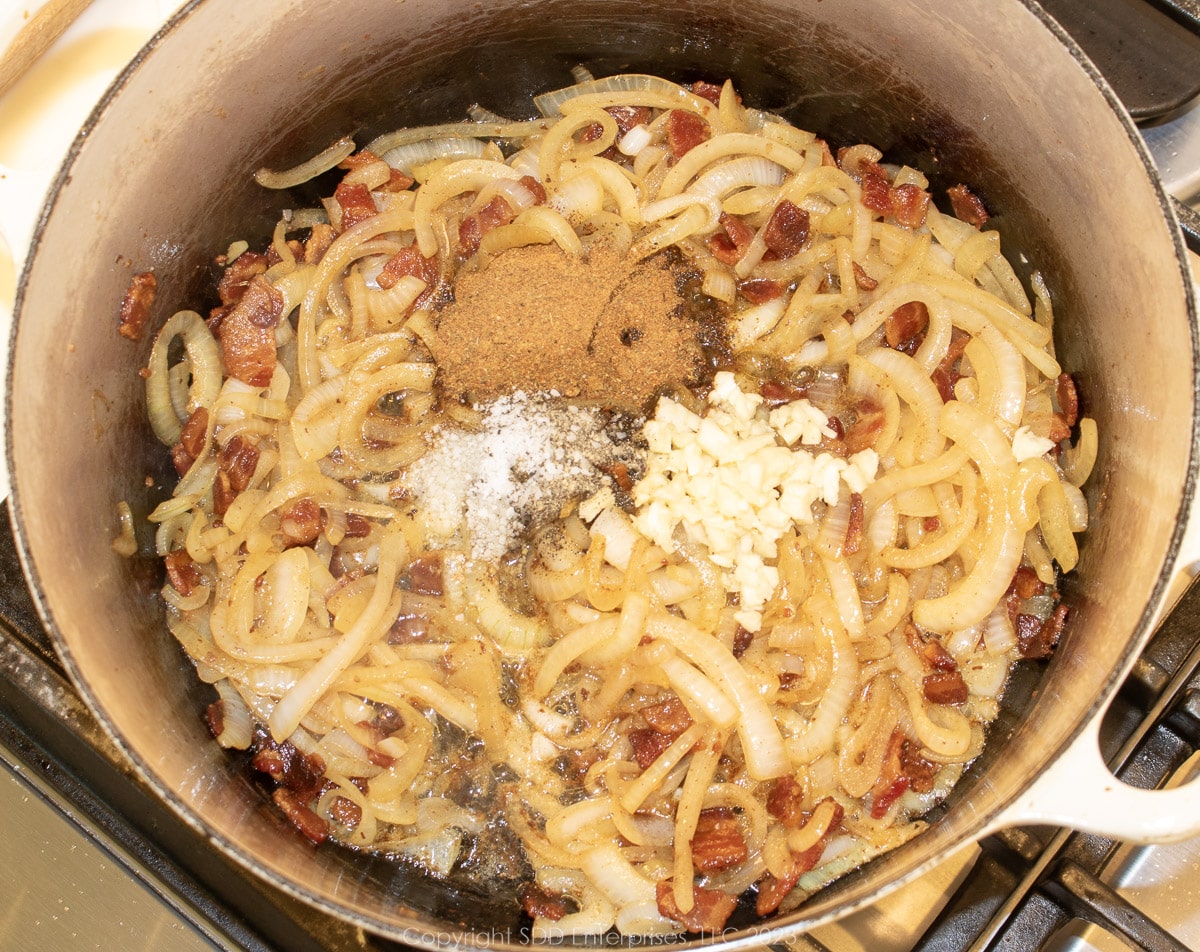
To the onions and aromatics, add the cubed turnips. Stir well to coat all the turnip cubes with the onion-garlic-bacon mixture. Continue to saute this veggie mixture for about 3 more minutes.

Smother the greens
What happens in this step? Braising fresh greens in a flavorful liquid will not only soften the naturally fibrous leaves it will help reduce the natural bitterness present in most leafy greens. The seasoned stock serves to distribute the flavors of the greens and fuses the flavor throughout the entire dish.
Add the chopped greens in batches, stirring and cooking down slightly before adding another batch. Make sure to mix the greens with the other vegetables thoroughly. This will take about 5 minutes.

Once all the greens have been incorporated, cover the Dutch oven. Simmer for about 5 more minutes to begin drawing out the natural liquid in the greens.

Remove the cover and stir in the cane syrup.

Next, add the reserved shank and about ½ cup of the stock.
Pro Tip: Start with just a little stock (about ½ cup). You may not need the entire 1 ½ cups as called for in the recipe. The amount of stock you use will depend on how much liquid the greens give up.

Increase the heat to a high. Once it reaches a simmer, lower the heat to maintain a medium simmer for about 1 hour or until the greens are very tender. Partially cover the Dutch oven during this time.

Pro Tip: The greens need to simmer in liquid as they smother. As the greens are simmering, if the liquid cooks off, add more stock. If you need the liquid to reduce faster, remove the cover completely. When the greens are done, you want the liquid to be about half as much as the greens.
Check the shank for tenderness. If it is very tender when probed, remove the shank from the Dutch oven and allow it to cool slightly. Once cooled enough to handle, pull the meat off the bone and shred it. If the meat is not totally tender, continue to simmer it uncovered until the shank is falling off the bone.

Return the shredded ham to the Dutch oven and stir well. Taste for seasoning and add more if necessary. Continue simmering uncovered as long as needed until the greens are completely tender.
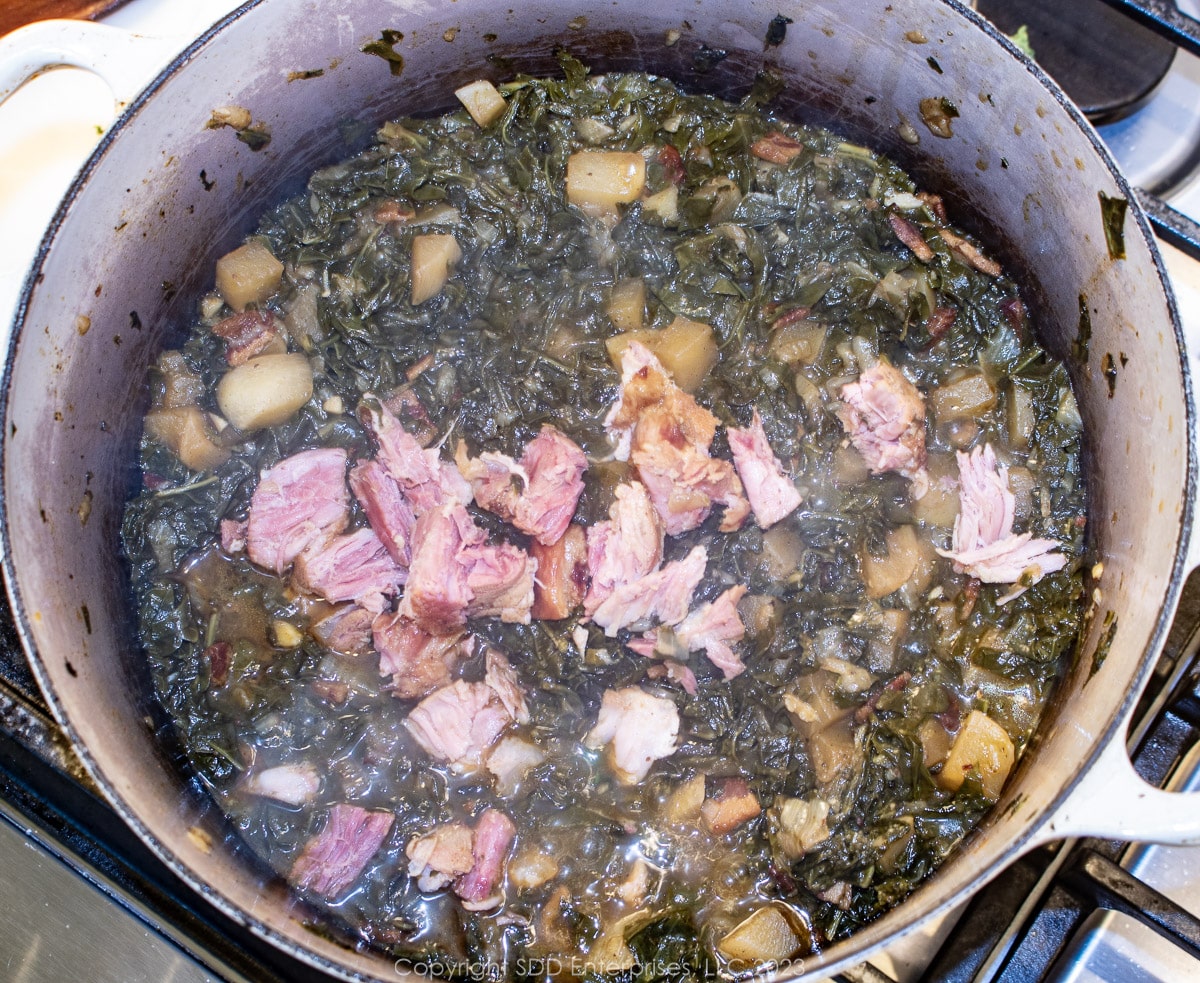
The Smothered Turnip Greens are ready to serve! Besides the delicious, tender greens and chunks of smoky ham, this recipe provides you with some lagniappe! This little something extra is Pot Likker (or pot liquor) which is the rich broth developed while braising your greens. This flavor-packed liquid is dying to have a chunk of cornbread or French bread dipped in it but can also be the base for other stocks and gravies.
Pot Likker is pure flavor and a cultural connection to the origins of Creole and Soul cooking. When writing about one of Leah Chase's recipes for smothered greens, renowned Master of South Louisiana Cuisine, John Folse, wrote:
John Folse, Leah Chase's Old Style Greens and "Pot Likker""Pot Likker" is the delicious juice that comes from the greens as they are cooked. I like to eat this juice separately with cornbread. That’s what I call down-home Southern food!
Sign up for my email notifications of new recipes and posts right HERE.
Hints and Tips (FAQs)
Leftover smothered Turnip Greens will last up to 4 days in the fridge. Make sure to allow the cooked greens to cool down, then place them in an airtight container before placing them in the fridge. Reheat on the stovetop or in the microwave.
Yes, these Turnip Greens will freeze well, maintaining their quality for up to 10 months. First, let the Turnip Greens cool down to room temperature. To discourage bacteria from forming, cool them down as quickly as possible by placing the bowl inside a large bowl or sink full of cold water and some ice. Once cooled down, place the Turnip Greens in an appropriate air-tight freezer container or vacuum-sealed bag, allowing some headroom for expansion when the water inside them freezes. Place the container in a zero-degrees Fahrenheit freezer for up to 10 months.
Turnip Greens are a great source of many essential nutrients without adding many calories. Check out this article from Medical News Today if you want a brief nerd-out on Turnip Greens' nutritional particulars.
Many leafy vegetables are naturally bitter and Turnip Greens are no exception. A touch of acid will help offset that bitterness. Getting that acid from the vinegar can also add a subtle bit of flavor in the background. In this recipe, I use Cane Vinegar (5% acidity) but you could use white or apple cider vinegar instead. Also, the cane syrup (or a substitute) as well as the long braising time also helps counter the bitterness and balance the smoky background.
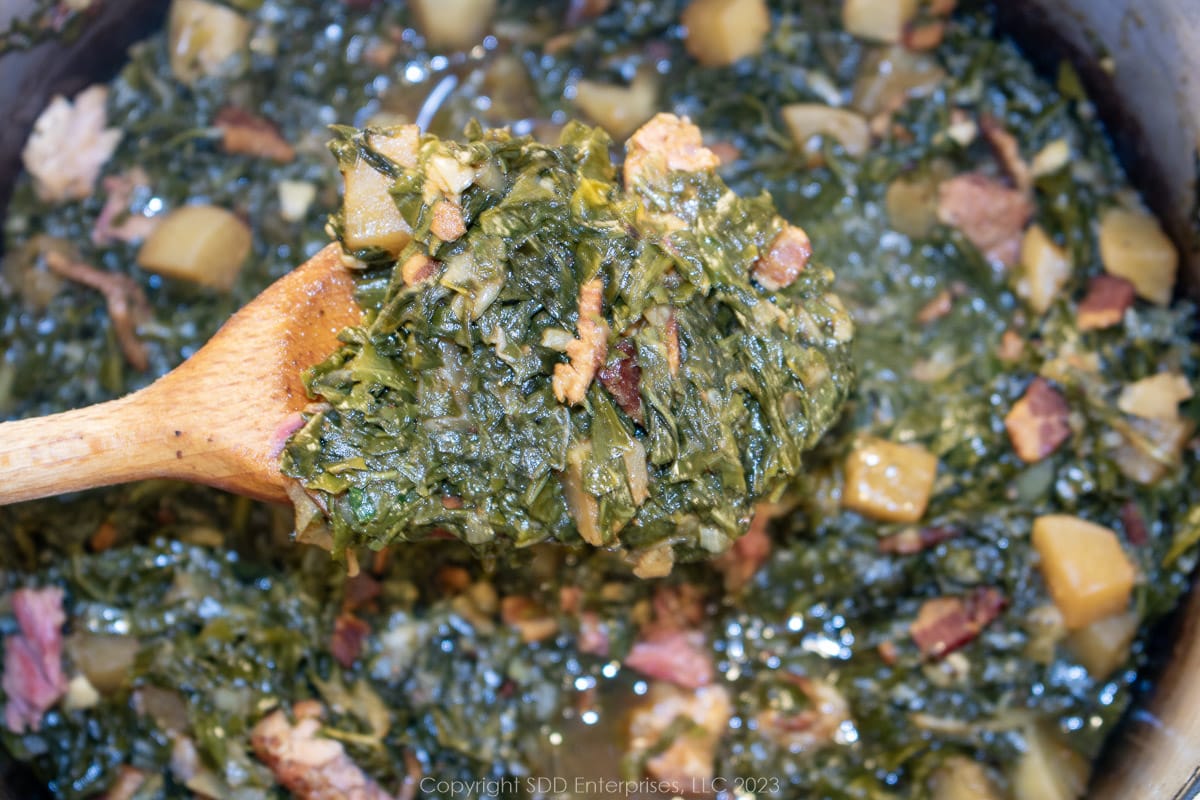
What can you serve Smothered Turnip Greens with?
Other great Cajun and Creole Side Dishes:
If you make this recipe:
- Tell us about it in the Comments section below
- LEAVE A RATING ON THE RECIPE-worthy of 5-Stars?
- Questions or Comments? that’s the place!
- SIGN UP FOR OUR EMAIL UPDATES so you don't miss anything!
- Post a picture and share it with your friends on our Social Media:
Yeah You Right!
Recipe

Turnip Greens
Here's What You Need
- 4 slices smoked bacon
- 1 Smoked ham shanks See Notes
- 6 quarts turnip greens about 2 ½ pounds cleaned and chopped
- 4 cups yellow onions
- 5 cloves garlic
- 2 cups turnips cubed
- 1 ½ cup chicken stock
- ¼ cup cane syrup optional, see Notes
- 1 Tablespoon Vinegar See Notes
Herb and Spice Blend
- 2 tablespoon Creole Seasoning
- 1 teaspoon Kosher Salt
- 1 teaspoon Ground Black Pepper
- 1 teaspoon thyme optional
- ½ teaspoon cayenne pepper optional
Here's What You Do
- Slice bacon into ½ inch chunks. Starting in a cold Dutch oven, fry the bacon until the fat has rendered. About 10 minutes
- Add the ham shank and sear for about 5 minutes, turning mid way. Remove the shank from the Dutch oven and reserve.
- Add the onions. Saute until sweated and turning translucent, about 8 minutes
- Add the garlic and the Herb and Spice Blend and saute until aromatic, about 2 minutes.
- Add the cubed turnips. Stir well to coat all the cubes in the onion garlic mixture and saute about 3 minutes.
- Add the chopped greens in batches, stirring and cooking down slightly before adding each batch. Stir well to thoroughly combine all the ingredients. This will take about 5 minutes.
- Cover the Dutch oven and simmer about 5 more minutes.
- Remove the cover. Add the vinegar and cane syrup and stir well. Add ½ cup of stock and stir well before adding back the ham shank. (See Notes)
- Increase the heat. Once the Dutch oven reaches a heavy simmer, back the heat down to a simmer. Partially cover the Dutch oven and maintain a medium simmer for 1 hour, stirring occasionally.
- Remove the lid and check the shank for tenderness. If the shank is not totally tender, continue to simmer for another 15 minutes, uncovered until the shank is falling off the bone.
- Remove the shank and pull the meat off the bone and shred.
- Return the shredded ham to the Dutch oven and stir well. Taste the greens for tenderness and seasoning. Add more seasoning as needed.
- If the greens are not tender enough for your taste, continue to simmer uncovered until the greens are completely tender.
Recipe Notes
- Use smoked ham, smoked ham hocks, smoked turkey necks or wings, tasso, or pickled pork in place of the ham shank.
- Use white or brown (light or dark) sugar or molasses for the Cane Syrup.
- I use Cane Vinegar (5%) but White or Apple Cider Vinegars are good.
- You can use potatoes in place of turnips or leave them out altogether.




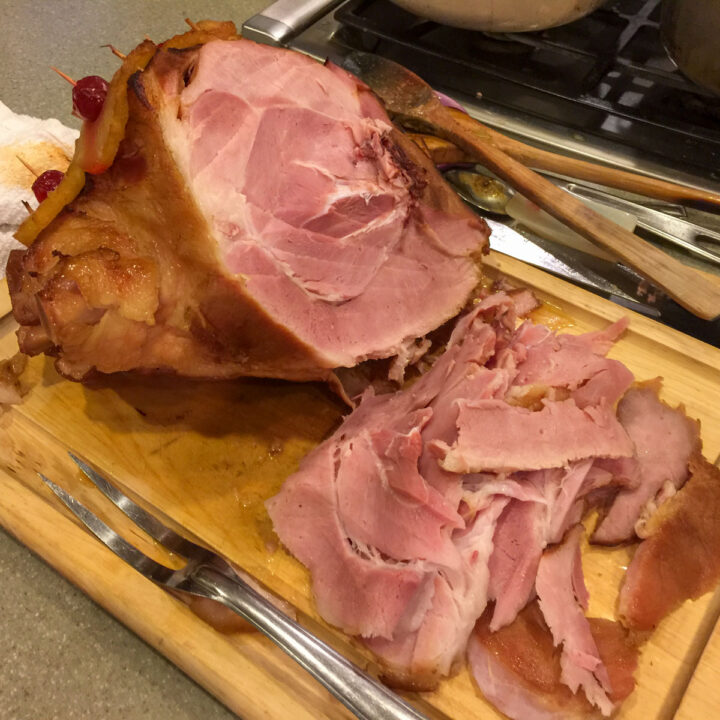


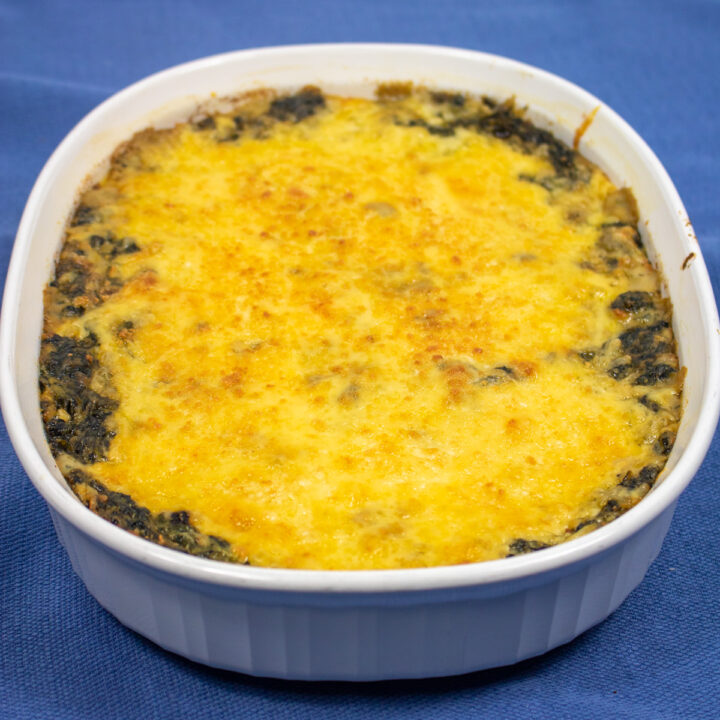
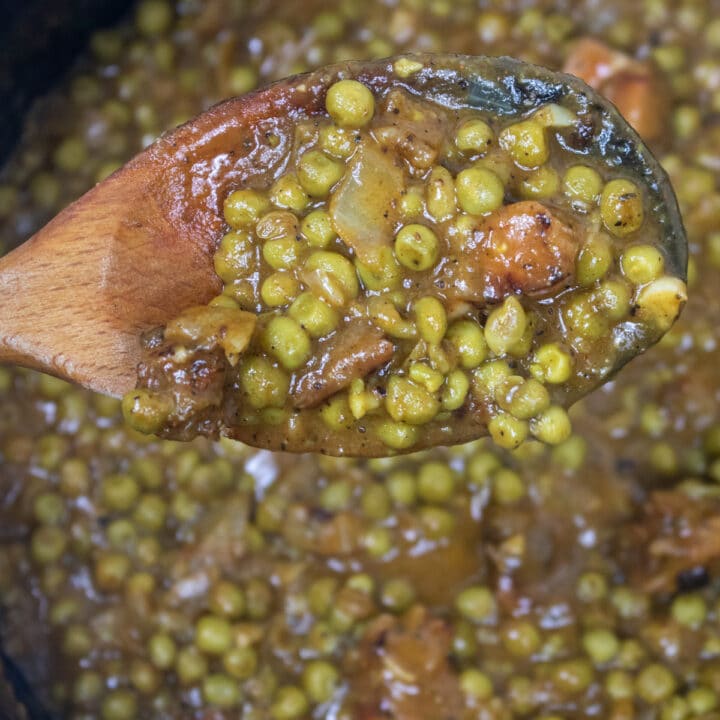

Comments
No Comments